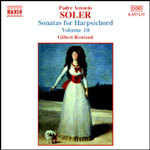
Sonatas for Harpsichord, Vol. 10
 $25.00
Out of Stock
$25.00
Out of Stock6+ weeks add to cart
SOLER
Sonatas for Harpsichord, Vol. 10
Gilbert Rowland (harpsichord)
[ Naxos / CD ]
Release Date: Friday 25 February 2005
This item is currently out of stock. It may take 6 or more weeks to obtain from when you place your order as this is a specialist product.
Owing mainly to the tireless efforts of the late Father Samuel Rubio and other editors in making many of his works available in print during the past forty years, Antonio Soler is now justly regarded as the most important composer active in Spain during the second half of the eighteenth century.
He was born at Olot, in the province of Gerona in north-eastern Spain in 1729 and baptised on 3rd December. At the age of six he entered the famous choir school at the Monastery of Montserrat where he studied organ and composition. Before that he probably received some tuition from his father, who was a regimental bandsman. In 1744 he was appointed organist at the cathedral in Seo de Urgel and was later ordained as subdeacon there.
At that time the Bishop of Urgel asked him if he knew of a boy who could play the organ and who wished to take holy orders at the Escorial. Soler volunteered himself, saying that he very much wanted to take the vows and retreat from the world, and so on 25th September 1752 he became a monk and entered that famous monastery near Madrid, built by Philip II. He also became master of the Chapel there, probably in 1757 following the death of his predecessor, Gabriel de Moratilla. Soler remained there until his death in 1783.
During the years 1752 to 1757 Soler is reputed to have studied composition with Domenico Scarlatti and many of Soler's sonatas show his influence to a marked degree both in form and musical language. Despite his probable debt to Scarlatti, however, Soler's own personality is very much in evidence in these works. Many of these sonatas, like Scarlatti's, are single movements in binary form, that is, in two sections, each of which is repeated, although Soler also composed a large number of multi-movement sonatas. It is quite possible that he was one of the copyists of some of the manuscript volumes of Scarlatti's sonatas, now housed in Venice and Parma.
Fortunately for posterity Soler's wish for a quiet life did not work out quite as he intended. Apart from his monastic duties he was expected to train the choir, provide choral music for services, and provide the Royal family with secular and instrumental music during their frequent visits to the Escorial. The Spanish court regularly spent the autumn there. Soler's achievement is also astonishing when considering that much of his day would have been taken up with prayer and the routine of the community. Periods of illness often prevented him from working. We learn from the anonymous obituary of Soler, written by a fellow monk on the day he died, that he survived on only four hours sleep most nights, often retiring at midnight or one o'clock in the morning before rising at four or five o'clock to say Mass. Mention is also made of his religious devotion, compassionate nature, scholarly interests and excessive candour. Soler died at the Escorial on 20th December, 1783, from a gradually worsening fever which he had caught the previous month. Soler's huge output runs to nearly 500 individual works, and of his 150 keyboard sonatas, most were intended for harpsichord.
Tracks:
Sonata in D flat major
Sonata No. 88 in D flat major
Sonata No. 77 in F sharp minor
Sonata No. 78 in F sharp minor
Sonata No. 37 in D major
Sonata No. 64 in G major
Sonata No. 126 in C minor
Sonata No. 61 in C major



